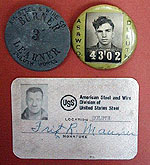By Stephanie Hemphill
Minnesota Public Radio
September 23, 2002
At one time, the biggest employer in Duluth was a steel mill. Just before World War I, U.S. Steel built a huge plant on the western edge of Duluth. Over the next 50 years, workers hammered out the steel posts and barbed wire that fenced the west, and steel for the tanks and planes that won the Second World War. At its height, 5,000 people worked at the mill. The plant was closed and torn down in the early 1970s. Now, the grandson of a mill worker is trying to capture some of the plant's history, before everyone who worked there is gone.
| |
|
|
|
||
What was once the giant U.S. Steel plant is now a fenced-off wasteland. Scrubby trees are pushing up through cracked asphalt and concrete. It's a super-fund site, and most people who drive by know nothing about what used to be here years ago.
Just a few blocks away, at the Morgan Park community center, Kyle Maunu greets old-timers. They stroll into the common room and look around at the display cases filled with pieces of their own history.
Kyle Maunu grew up in Duluth, but he didn't know much about the plant. His grandfather, Fritz Maunu, worked at the mill. But Kyle never really heard about it.
"He died before I was old enough to appreciate any of the stories that he could have told," says Maunu.
But Kyle studied history in college, and became fascinated with the place where his grandfather had worked.
| |
|
|
|
||
"I literally started out with one small ID card from my Grandpa Fritz," Maunu says. "It seemed like everybody saved their own little piece of the steel plant story."
Maunu felt he had one piece, but he wanted to hear more of the story. Last spring, he put out a call, asking people who had things related to the steel plant to lend or donate them for an exhibit. He's had lots of calls from people who worked at the plant, or their relatives, wanting to share stories and treasures.
Like Lloyd Nelson. He grew up in Morgan Park and worked in the mill for many years.
Nelson worked in the merchant mill, making things like fenceposts, and also in the wire mill and the rod mill.
Looking around at the items his former co-workers have donated, Nelson can't help remembering the awful noise of the plant.
| |
|
|
|
||
"Loud noise, train whistles, horns, and everything else," Nelson recalls.
The noise is what Donna Swanson remembers too. "I remember going through the plant when they had the visitation," she says. "And in the nail room, I thought anybody who worked there should get a million dollars, the noise was so terrible!"
No wonder it was loud. The plant was more than 40 buildings, crowded on a square mile of land. Some of the buildings were a half-mile long. There was a furnace that turned coal into hotter-burning coke. A blast furnace turned ore into steel slabs. Mills hammered out nails, wire, and fenceposts. And a cement plant nearby used waste from the iron ore to make cement.
Many people spent their entire working lives at the mill. Walt Smith was one.
| |
|
|
|
||
"I was over here in Morgan Park in the 10th grade," he remembers. "The employment office for US Steel was right across the street. I left school at 16, went across the street, got hired by U.S. Steel in 1940, and I worked there until 1974."
Smith married a woman whose father and five brothers worked at the plant. Many families had several members on the job there. The pay and benefits were good compared to other jobs in the area. A man could hope his sons would follow him into the mill.
The plant operated for 50 years. Eventually it succumbed to competition from bigger mills in Chicago, and imports from other countries. The buildings were torn down, and now there's nothing left but crumbling foundations and polluted land.
Kyle Maunu collected lots of things from people who once worked at the plant. Everything from equipment for testing ore samples, to pay stubs. (In the 1940s, wages were 60-some cents an hour.) Blueprints for some of the buildings are on display, along with tie clips given to men who put in 30 years. Maunu says the exhibit will stay on display here indefinitely.
| |
|
|
|
||
So far, it's mostly older people who have come to see the exhibit. But he's hoping neighborhood kids and school classes will come.
"The younger generation really doesn't realize the importance that this plant played in Duluth's history, on a scale that Duluth and in some ways the state has never seen," Maunu says. He wants younger people to know.
And Kyle Maunu says he's learned a lot too. People who worked with his grandfather have told him lots of stories about life at the steel plant in Fritz Maunu's day.





